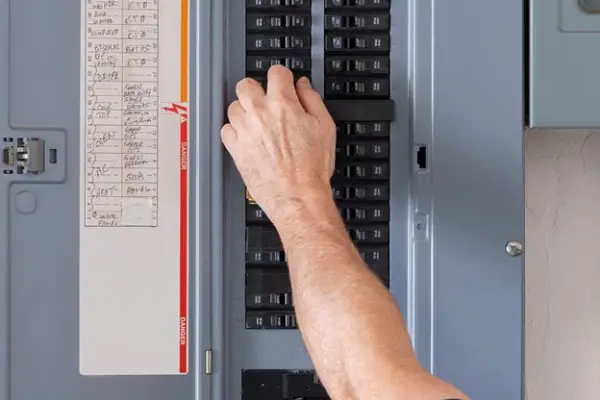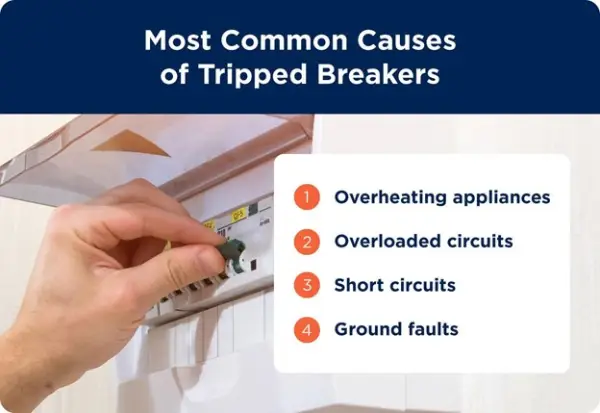Why Your Breaker Keeps Tripping
 A faulty circuit breaker is not only annoying but could be a sign of a bigger problem. The most likely reasons for this problem are an overloaded circuit, overheated appliance, electrical short, or ground fault issue. Each of these problems has several potential causes, so troubleshooting the specific issue can quickly become complex and frustrating.
A faulty circuit breaker is not only annoying but could be a sign of a bigger problem. The most likely reasons for this problem are an overloaded circuit, overheated appliance, electrical short, or ground fault issue. Each of these problems has several potential causes, so troubleshooting the specific issue can quickly become complex and frustrating.
If your breaker keeps tripping, you need to address it immediately — ignoring the issue could result in major electrical damage, electrical shock, or even a fire.
Let’s walk through a few simple steps that can help determine the source of the problem. Once you identify the source, you can safely resolve it with the help of an expert.
 1. Overheating Appliance
1. Overheating Appliance
When an appliance overheats, it may cause the breaker to trip. This is especially common with units that require high power, including:
- Washers and dryers
- Microwaves
- Air conditioners
- Dishwashers
- Refrigerators
- Ovens
Overheated appliances are often caused by human error, such as overloading a dryer. Think about the major appliances on the circuit you’re having trouble with. Have you used one of your appliances more frequently lately? Does the appliance get very hot when in use?
However, if you’ve been using your appliances correctly, but they are still overheating, it could be due to another reason. For example, a vent is blocked, a component has worn out, or there’s an electrical short somewhere.
How to fix it:
- Keep your appliances clean: Regularly clean dirt, dust, and grease that accumulate on the coils and cables of appliances like stoves, refrigerators, and dryers. For instance, clean the refrigerator's condenser coils using a coil brush or a vacuum to remove debris.
- Be careful with cords and outlets: Avoid overloading outlets or extension cords beyond their capacity. Ensure electrical connections are secure and inspect the insulation around appliances periodically. Unplug appliances when not in use to prevent them from generating heat.
- Check the condenser: Keep an eye on appliance condensers like refrigerators, freezers, and dryers, especially during the summer months. Clogged condensers can cause overheating.
- Practice preventative maintenance: Remove lint from the dryer after each load to prevent overheating and potential fire hazards.
Ultimately, if you suspect your appliance is overheating, reach out to Mr. Appliance® for a full assessment and maintenance check of the unit. If your appliance doesn’t appear to be overheating, move on to the next troubleshooting step.
2. Overloaded Circuit
When a circuit tries to draw more power than it is designed for, the circuit wires heat up. As a result, the circuit breaker trips, which cuts off the flow of electricity to prevent further problems and potential damage to the circuit. If you’re experiencing any of the following warning signs, it’s likely the result of an overloaded circuit breaker:
- Flickering or dimming lights
- Buzzing or humming sounds
- Burning smells
- Warm-to-the-touch wires
How to fix it:
- Identify the overloaded circuit: Determine which circuit is overloaded by unplugging some of the appliances or devices that are currently in use.
- Switch the tripped breaker on: Switch the tripped breaker to the OFF position and then back to ON.
- Plug your appliances back in: Plug your appliances and electronics back in, one at a time. Stop this process immediately if you see any damage to wall outlets or external wires.
- Shift devices to another circuit: Shift some devices from the overloaded circuit to another general-purpose circuit to reduce the load on the overheated circuit.
- Use appliances sequentially: Use only one high-wattage appliance at a time to prevent overloading the circuit.
- Install dedicated circuits: Consider having a professional install dedicated circuits for high-power appliances to reduce the chance of an overload.
- Use energy-efficient appliances: Energy-efficient appliances can help prevent overloaded circuits by reducing the overall power demand, ensuring the electrical load remains within the circuit's capacity, and minimizing the risk of circuit breaker trips.
If the issue persists, seek professional help from an experienced electrician like Mr. Electric to diagnose the source of your tripped breaker. It may indicate that you need to replace outdated circuits or repair or replace faulty wiring.
3. Short Circuit
A short circuit is a low-resistance connection between two points in an electrical circuit, typically resulting in excessive current flow and potential damage to the components involved. This can occur in an outlet, a switch, or inside an appliance when the following happens:
- A hot wire comes into contact with another hot wire, a neutral wire, or the ground.
- Wires are damaged or severed (e.g., from rodent damage).
- Components in an appliance or electrical system are damaged or loose.
Short circuits create a surge of electricity that, at a minimum, can cause a breaker to trip. They can also lead to overheating, electrical fires, and damage to electronic devices, systems, and appliances, posing significant property and personal safety risks. Identifying and promptly addressing short circuits is crucial to preventing these potential hazards.
How to fix it:
- Reset the breaker: Unplug all appliances and turn off switches on the circuit. Reset the breaker and observe if the short occurs immediately, indicating a problem with the circuit or electrical system as a whole. If not, the issue is likely within a specific circuit.
- Isolate the culprit: If the short is isolated to a specific circuit, systematically flip light switches to identify the location of the short. If the short does not occur, the problem may be with a specific appliance. Plug in the appliances one by one to identify the cause of the short.
- Call a professional: Fixing a short circuit can be complex and potentially dangerous — do not attempt to DIY a short circuit repair. When an appliance repair expert like Mr. Appliance diagnoses an electrical short problem, they not only look for visible damage to wires and parts; they’ll also test the outlet to determine whether the short circuit is occurring within the appliance or at the outlet or switch.
4. Ground Fault
A ground fault is a specific type of short circuit that occurs when a hot wire (current flowing through it) touches a grounded part of a switch box, appliance, or bare ground wire. This event causes the breaker and GFCI (ground fault circuit interrupter) outlets to trip. Ground faults may occur due to the following:
- A water leak
- Wire damage
- Appliance damage
Because ground faults can be a dangerous indicator that water and electricity are making contact, it’s highly recommended that you leave all the troubleshooting and repair work to an appliance repair expert from Mr. Appliance or a licensed electrician from Mr. Electric. Do not attempt to repair a ground fault yourself.
Notice Any Other Appliance Problems?
A constantly tripped circuit can be an inconvenience, but if left unchecked, it could lead to even bigger headaches and even cause damage to your appliances and home. So, whenever you're struggling to keep your appliances running efficiently, you can count on your local Mr. Appliance for prompt, expert repair service and upfront, flat-rate prices. Schedule an appointment online or call us today.
FAQ About Breakers That Keep Tripping
If you've ever experienced sudden power interruptions, you're not alone. Tripped breakers can be a puzzling occurrence, often leaving homeowners with questions about the causes, potential risks, and solutions. We answered a few of the most frequently asked questions to assist you in navigating the intricacies of electrical circuits and ensure a safe and reliable power supply.
Can a Breaker Go Bad if It Keeps Tripping?
Yes, a breaker can go bad if it keeps tripping. Breakers are designed to protect electrical circuits from overloads and short circuits by automatically shutting off the power when such issues arise. However, persistent tripping can lead to wear and tear on the internal components of the breaker, causing stress on the breaker's mechanical and thermal elements and potentially leading to outright failure.
How Do You Know if a Breaker Is Bad?
If a breaker keeps tripping without an apparent cause, it may indicate the breaker is bad. Visually inspect the breaker for signs of overheating and damage, such as:
- Discoloration
- Burning
- A burnt smell
- A buzzing or crackling noise
Test the breaker by manually switching it off and then on again; a breaker that refuses to reset or feels loose may be faulty.
If this check reveals abnormalities or if the breaker continues to trip despite addressing potential issues, consult a qualified electrician for a professional assessment.
What Usually Causes a Breaker to Trip?
Breakers most often trip due to overloading when the current flowing through the circuit exceeds the breaker's rated capacity. This can happen when too many devices are connected to a single circuit or when power-hungry appliances are in use simultaneously.
How Do You Fix a Breaker That Keeps Tripping?
To fix a breaker that keeps tripping, you should first identify the cause. Some of the most common reasons for a tripped breaker are overloading, a short circuit, a ground fault, or a faulty appliance.
If overloading is the issue, redistribute devices across different circuits to ensure a balanced load, unplug any unnecessary devices, and refrain from using high-powered appliances simultaneously.
Short circuits, ground faults, and overheating appliances will likely need to be fixed by a service professional. Contact your local Mr. Appliance for a thorough assessment and repair.
 Click to call
Click to call


